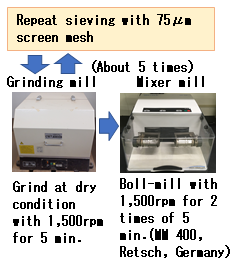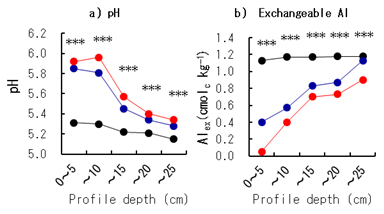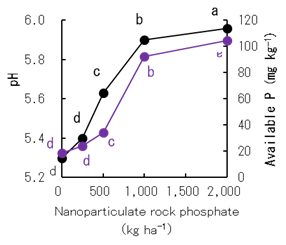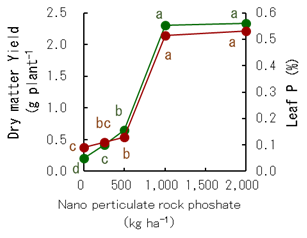Assessing nanoparticulate lime and phosphate rock and increasing their efficiency as a liming agent and phosphorus source, respectively
Description
Acid soils occupy approximately 43% of the world’s tropical land area. Although they have high potential for agriculture production, plant growth is hindered by the low availability of P, Ca, and Mg, and the acidity-related toxicity of Al, Fe, and Mn. Application of conventional lime and soluble P fertilizer is considered general practice for correcting acidity and nutrient deficiencies in acid tropical soils. As the prices of lime and P fertilizers have increased markedly worldwide, there is an urgent need for new materials that achieve goals at a reduced cost.
Nanoparticulate lime (NL) or phosphate rock (NPR) can be used as an alternative by increasing its efficiency. Reducing the particle to nanoscale (Fig. 1) and thus increasing the total surface area could offer a mechanism to increase the efficiency of lime and phosphate rock (Devnita et al. 2018, Liu and Lal 2015). This study was, therefore, conducted to assess NL and NPR to increase their efficiency as a liming agent and phosphorus source, respectively.
Applying NL to the top 5 cm at 40 and 80 kg ha-1 was effective at increasing the downward movement of Ca and the neutralization of soil acidity (in terms of pH) to 20 cm depth, as well as rectifying Al toxicity (in terms of exchangeable Al) to ≤ the critical limit to 10 cm (Fig. 2). The NL at 80 kg ha-1 was most economically justified in terms of rectifying Al toxicity throughout the profile.
NPR (Fig. 1) significantly affected soil pH after harvest (Fig. 3). NPR at 250 kg ha-1 and 500 kg ha-1 increased soil pH, though not to the levels required to promote spinach growth, while NPR at 1,000 and 2,000 kg ha-1 increased soil pH within the optimum range (typically 6.4-6.8). Increasing NPR significantly increased available P after harvest. NPR at 2,000 kg ha-1 released 56 mg P kg-1 (upper limit for spinach), while NPR at 1,000 kg ha-1 released 35 kg P ha-1 (target limit).
NPR significantly increased dry matter yield (DMY, Fig. 4). NPR at ≥1,000 kg ha-1 increased DMY by ≤11.5x the initial value, while NPR at <1,000 kg ha-1 increased DMY by ≤3x. DMY did not increase significantly from 1,000 to 2000 kg ha-1. Therefore, the critical threshold or application rate that produced the maximum yield (2.3 g DMY plant-1) is 1,000 kg ha-1. NPR also significantly increased leaf P. NPR at 2,000 kg ha-1 increased leaf P the most, but not significantly more than at 1,000 kg ha-1. The leaf P concentration varied from 0.1% to 0.53% among NPR rates. When NPR rate was ≥1,000 kg ha-1, leaf P was about ≤5.8x the initial value. According to the diagnostic range for P in spinach leaf, NPR at ≥1,000 kg ha-1 increased available soil P to at least the upper limit.
In summary, the soil and plant parameters increased to the same degree at 1,000 and 2,000 kg ha-1. Therefore, the use of 1,000 kg ha-1 is more economically justified. Regular application of NPR and further research for economic comparison between NPR and both of lime and superphosphate will be needed.
Figure, table
-
Fig. 1. Nanoparticulation process
Burkina Faso phosphate rock was used. -
Fig. 2. pH and exchangeable Al of the simulated plough layer with a different nanoparticulate lime (NL)
NL leached with 28cm of water over 40 days; ***: p<0.001 (ANOVA)

-
Fig. 3. Effects of nanoparticulate phosphate
Data were collected at the end of the growth period (49 days) after pre-incubation (21 days). Different letters show significant difference (Tukey’s HSD). -
Fig. 4. Effects of nanoparticulate phosphate rock on spinach dry matter yield and leaf P concentration
Data were collected at the end of the growth period (49 days) after pre-incubation (21 days). Different letters show significant difference (Tukey’s HSD).
- Affiliation
-
Japan International Research Center for Agricultural Sciences Tropical Agriculture Research Front
- Classification
-
Technical A
- Research project
- Program name
- Term of research
-
FY2019 (FY2016-FY2020)
- Responsible researcher
-
Omae Hide ( Tropical Agriculture Research Front )
MIERUKA ID: 001794Abd El-Halim Awad Abd ( Tanta Universirty )
ORCID ID0000-0001-8720-6025 - ほか
- Publication, etc.
-
https://doi.org/10.1080/00380768.2019.1620082
Abd El-Halim AA and Omae H (2019) Soil Science and Plant Nutrition 65(4):386-392
https://doi.org/10.1111/sum.12525Abd El-Halim AA and Omae H (2019) Soil Use and Management 35:683-690
- Japanese PDF
-
2019_A04_A4_ja.pdf682.94 KB
2019_A04_A3_ja.pdf266.8 KB
- English PDF
-
2019_A04_A4_en.pdf273.38 KB
2019_A04_A3_en.pdf304.77 KB
- Poster PDF
-
2019_A04_poster_fin.pdf315.11 KB




